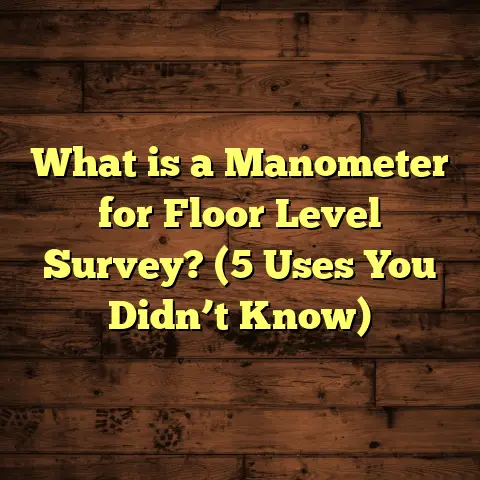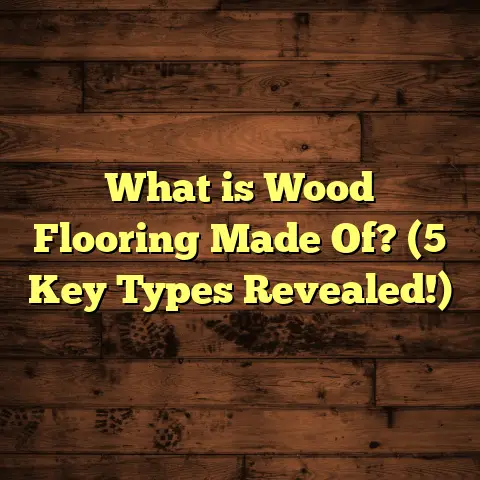What is Better: Laminate or Vinyl Plank Flooring? (5 Key Differences)
When I think about flooring, the first thing that comes to mind is value for money. You want a floor that looks good, lasts long, and doesn’t break the bank—not just at purchase but over time. I’ve worked in the flooring business for many years, installing and advising on both laminate and vinyl plank flooring. Each has its perks and pitfalls. The decision between these two isn’t always straightforward, especially if you’re trying to balance cost, durability, style, and maintenance.
So, let’s chat about laminate and vinyl plank flooring. What are they? How do they differ? Which one makes more sense for your home or project? I’ll share my experiences, insights from recent research, and practical advice to help you find the best fit.
What Exactly Are Laminate and Vinyl Plank Flooring?
Before we jump into the differences, it’s important to understand what each flooring type actually is.
Laminate Flooring
Laminate flooring has been around since the 1970s and has steadily grown in popularity. It’s a multi-layer synthetic flooring product fused together through a lamination process. The core is usually made from high-density fiberboard (HDF), which is compressed wood fibers mixed with resins. On top of that is a high-resolution photographic layer that mimics natural materials—usually wood grain but sometimes stone or tile patterns. Finally, a clear protective wear layer covers everything, giving laminate its scratch resistance.
One thing I always point out to clients is that laminate flooring is not real wood. It doesn’t sand or refinish like hardwood can. But it’s designed to replicate the look of wood at a fraction of the price.
Vinyl Plank Flooring
Vinyl plank flooring is part of the broader category of resilient flooring made from synthetic materials — mainly polyvinyl chloride (PVC). It’s been around even longer than laminate but has recently surged in popularity due to advances in design and performance.
Vinyl plank flooring comes in long strips or planks that look like hardwood boards. Unlike laminate, vinyl plank is made from a solid waterproof material that often has a cushioned backing for comfort underfoot. It can be rigid core (like WPC or SPC) or flexible sheet vinyl cut into planks.
The top layer is a wear layer with a printed design underneath that mimics wood grain or stone textures. Today’s luxury vinyl planks (LVP) are so realistic they fool many people into thinking they’re actual hardwood.
1. Durability and Water Resistance: Which Flooring Lasts Longer?
Durability is one of the most important factors when choosing flooring. I always ask my clients: “How much wear and tear will this floor get? Are you worried about kids or pets? Will it be exposed to moisture?”
Laminate’s Strengths and Weaknesses
Laminate floors are surprisingly tough against scratches, dents, and daily scuffs because of their hard top layer. I installed laminate flooring in my own living room about 7 years ago, and it’s held up very well despite having two dogs who love to run around.
That said, laminate has a critical weak spot—water. Even though it’s somewhat resistant to spills if wiped quickly, exposure to moisture over time causes the fiberboard core to swell and warp. I’ve seen many cases where laminate flooring near sinks or entryways suffered damage after water seeped underneath.
A study by the American Society for Testing and Materials (ASTM) found that typical laminate boards absorb moisture at a rate 4 times higher than vinyl planks under similar conditions. So if you’re considering laminate for kitchens or bathrooms, beware.
Vinyl Plank Flooring’s Water Resistance
Vinyl plank flooring really shines in wet environments. Because it’s made from PVC with waterproof cores (especially rigid cores like SPC), it doesn’t swell or warp when exposed to water.
I installed vinyl plank in a basement apartment prone to humidity and occasional flooding. Years later, the floor still looked brand new — no swelling or bubbling.
According to data from FloorScore, many vinyl plank products have water resistance ratings exceeding 90%, compared to laminate floors which typically rate below 40%.
Vinyl plank is often recommended for moisture-prone areas like bathrooms, laundry rooms, kitchens, and basements for this reason alone.
Real-World Durability
I remember one job where a client wanted laminate in their kitchen. I advised against it due to water risk but they insisted on the look and cost advantages. Sure enough, after a year of kitchen spills and mop water, several boards swelled and had to be replaced.
In contrast, another client used vinyl plank in their kitchen and has had zero issues despite regular spills and steam from cooking.
2. Appearance and Style: Which Looks More Realistic?
When selecting flooring, appearance matters a lot. You want something that matches your style and complements your space.
Laminate Flooring Appearance
Laminate flooring uses high-resolution photographic layers to mimic wood grains or stones. When I first saw laminate years ago, it looked pretty convincing but felt somewhat “flat” underfoot due to its smooth surface.
Over time, laminate manufacturers improved textures by embossing surfaces to simulate wood grain patterns more realistically. Still, laminate tends to have a more uniform look—great if you want a clean, consistent pattern throughout your home.
I installed a mid-range laminate in a client’s dining room last year that fooled some guests into thinking it was hardwood — mostly because of its matte finish and subtle grain texture.
Vinyl Plank Appearance
Vinyl plank flooring has evolved significantly in aesthetics. Today’s luxury vinyl planks can feature deep embossing that replicates natural wood textures like hand-scraping and wire brushing.
Some higher-end vinyl planks even use multiple layers of color printing combined with grain embossing to create stunningly realistic hardwood looks. I’ve had clients ask if their vinyl was real hardwood — especially when paired with proper trim and baseboards.
Vinyl also offers more variety than laminate — from rustic wood looks to modern gray tones and even stone patterns.
Which One Wins on Style?
If you want authentic wood texture feel underfoot, vinyl plank usually takes the prize due to its embossed surface.
Laminate can look very good visually but feels harder and less natural.
The choice might come down to what style fits your décor best or your budget constraints since high-end vinyl plank flooring can be more expensive than laminate.
3. Installation: Which Is Easier for DIY or Pros?
A big reason both laminate and vinyl plank have become so popular is their relatively easy installation process — floating floors with click-lock systems that don’t require nails or glue in many cases.
But there are some nuances based on my experience:
Installing Laminate Flooring
Laminate requires a smooth, level subfloor — usually plywood or concrete with proper moisture barriers underneath. This prep work can sometimes take longer than the actual installation.
The click-lock system is straightforward for most people familiar with DIY projects but aligning boards carefully is essential to avoid gaps or buckling later.
One tricky part: because laminate isn’t waterproof, you need to install underlayment that acts as a moisture barrier especially on concrete slabs or basements.
I remember helping a first-time DIYer install laminate in their guest room. They spent hours leveling the subfloor and learning how to lock planks tightly together. It took patience but the result was satisfying.
Installing Vinyl Plank Flooring
Vinyl plank installation tends to be more forgiving when it comes to subfloor imperfections because of its flexible nature (especially flexible vinyl) or rigid core designs that can span minor gaps.
Its waterproof core means less concern about moisture barriers during installation in kitchens or bathrooms.
Some vinyl planks come with peel-and-stick backings making installation even easier for beginners.
I recently helped install vinyl plank floors in a rental unit where time was tight. We finished much faster than expected since there wasn’t much subfloor prep needed.
Overall Installation Thoughts
If you’re completely new to flooring installation or want the fastest setup with least prep work, vinyl plank may be more user-friendly.
For those willing to spend extra time prepping for a solid floor feel with less bounce underfoot, laminate’s click-lock system works great too.
4. Maintenance: What Floors Save You Time and Hassle?
Maintenance is another area where these two floors differ quite a bit — especially if you have kids or pets running around like mine do!
Maintaining Laminate Floors
Laminate’s durable surface makes it resistant to scratches from shoes or pet claws but it needs careful cleaning:
- Avoid excess water during mopping; damp mop only.
- Use cleaners designed specifically for laminate.
- Avoid abrasive tools or harsh chemicals.
One client told me she loved her laminate floor but got frustrated having to clean up every spill quickly before it damaged the floor.
Maintaining Vinyl Plank Floors
Vinyl plank floors are far easier here:
- They tolerate wet mopping.
- They resist stains well.
- You can use mild detergents without worry.
My personal experience with vinyl plank floors at home involves simple sweeping and mop cleaning weekly — no special cleaners needed even with kids spilling juice regularly!
Which Is More Practical?
If you want low-maintenance floors that survive everyday messes without stress, vinyl plank edges out laminate again for ease of care.
5. Cost: What Will You Actually Pay?
Cost is usually one of the biggest deciding factors for homeowners or contractors alike. Here’s where things get interesting based on my projects combined with market data:
Material Costs
- Laminate flooring typically ranges between $1 and $3 per square foot.
- Vinyl plank flooring materials range from $2 to $5 per square foot depending on quality.
Installation Costs
Installation costs vary widely based on location and complexity but generally:
- Laminate installation costs run around $2-$5 per square foot.
- Vinyl plank installation runs $3-$6 per square foot due to additional benefits like waterproofing.
Using FloorTally for Accurate Estimates
For every project I handle — whether residential or commercial — I rely heavily on tools like FloorTally. It helps me input local labor rates and materials prices plus factors in waste percentages so my estimates are realistic.
FloorTally has saved me headaches by preventing under-budgeting which happens often when clients think just material costs matter but forget installation labor plus waste materials needed for cuts or mistakes.
For example: A 1,000 square foot room with mid-range vinyl plank might cost:
- Material: $3 x 1,000 = $3,000
- Labor: $4 x 1,000 = $4,000
- Waste factor (around 7%) adds $210 on materials alone
- Total estimated cost = $7,210 approximately
Without such tools, it’s easy to underestimate total costs by thousands of dollars!
Long-Term Cost Considerations
While laminate is cheaper upfront, potential water damage repairs add hidden costs over time. Vinyl plank’s higher initial price often pays off by avoiding these issues entirely — especially in wet areas.
Why I Sometimes Recommend Laminate Over Vinyl Plank (And Vice Versa)
After working across dozens of homes and businesses installing both floors, here’s my personal take:
- For dry areas like bedrooms or formal living rooms where water risk is low but you want a budget-friendly option that looks good — laminate works great.
- For wet areas like kitchens, bathrooms, basements — vinyl plank’s waterproof nature makes it far superior.
- If pets and kids are part of your household chaos (like mine!), vinyl plank offers durability plus easy cleaning that saves headaches.
- If your priority is authentic wood feel underfoot with matte finish — laminate may edge out vinyl slightly unless you invest in premium luxury vinyl.
- For DIY installations with minimal subfloor prep time — vinyl plank usually makes more sense due to forgiving nature.
- If you want to save money upfront but understand potential risks — laminate is fine if used carefully away from moisture sources.
Some Case Studies From My Projects
Case Study 1: Family Home Basement Renovation
A family wanted new flooring in their basement recreation area where humidity was sometimes high. They were torn between laminate (cheaper) and vinyl plank (more expensive).
I suggested vinyl plank because of moisture risk in basements. The family went for mid-grade luxury vinyl plank with SPC core.
Two years later? The floor still looks flawless despite occasional wet boots tracked inside by kids playing outside during rainstorms.
Case Study 2: Urban Apartment Living Room Upgrade
A young professional wanted affordable flooring that looked upscale in their downtown apartment living room — no moisture issues expected.
We installed high-quality laminate with realistic wood grain finish. The floor gave the space warmth without breaking their budget.
Six months later they reported zero damage despite having pets running around daily.
Case Study 3: Kitchen Remodel With Budget Constraints
A couple remodeled their kitchen on a tight budget but wanted waterproof floors due to frequent cooking spills.
They opted for mid-range vinyl plank flooring installed professionally. The floor handled spills without problems right out of the gate.
They were pleased with the style variety available too — choosing a gray-toned plank that matched their cabinets perfectly.
Final Thoughts — What Should You Take Away?
Choosing between laminate and vinyl plank flooring isn’t about declaring one better than the other universally. Instead:
- Think about where you plan to install the floor.
- Consider your budget, lifestyle, and maintenance preferences.
- Use reliable tools like FloorTally for accurate cost planning so your project stays on track.
- Don’t overlook subfloor preparation needs since they affect installation success.
- Remember long-term durability versus upfront cost trade-offs carefully.
If you asked me today what I’d pick for my own home? For dry areas like bedrooms or offices: I’d go laminate for value and style. For kitchens/bathrooms/basements: hands down vinyl plank every time due to waterproof properties.
What about you? Are you leaning one way already? Need help sizing your space or estimating costs? Just ask—I’m happy to share more tailored advice based on what I’ve seen work best over thousands of square feet installed!
Bonus: Some Quick Tips When Choosing Between Laminate & Vinyl Plank
- Check product warranties carefully—some laminates offer limited water resistance while others don’t.
- Higher-priced luxury vinyl planks usually have thicker wear layers which extend lifespan.
- Consider sound insulation—vinyl tends to absorb footsteps better but underlayment options vary.
- Think about resale value; well-installed floors add appeal but real hardwood still tops them both here.
- Don’t rush installation—taking time prepping subfloors pays off big in long-term performance.
Thanks for sticking through this detailed chat! Flooring choices can feel overwhelming but breaking down key differences helps make smart decisions easier—and saves money/time down the road.
If you want me to help crunch numbers using FloorTally for your project or give hands-on installation tips based on your space details—let me know! It’s what I do best after all.





